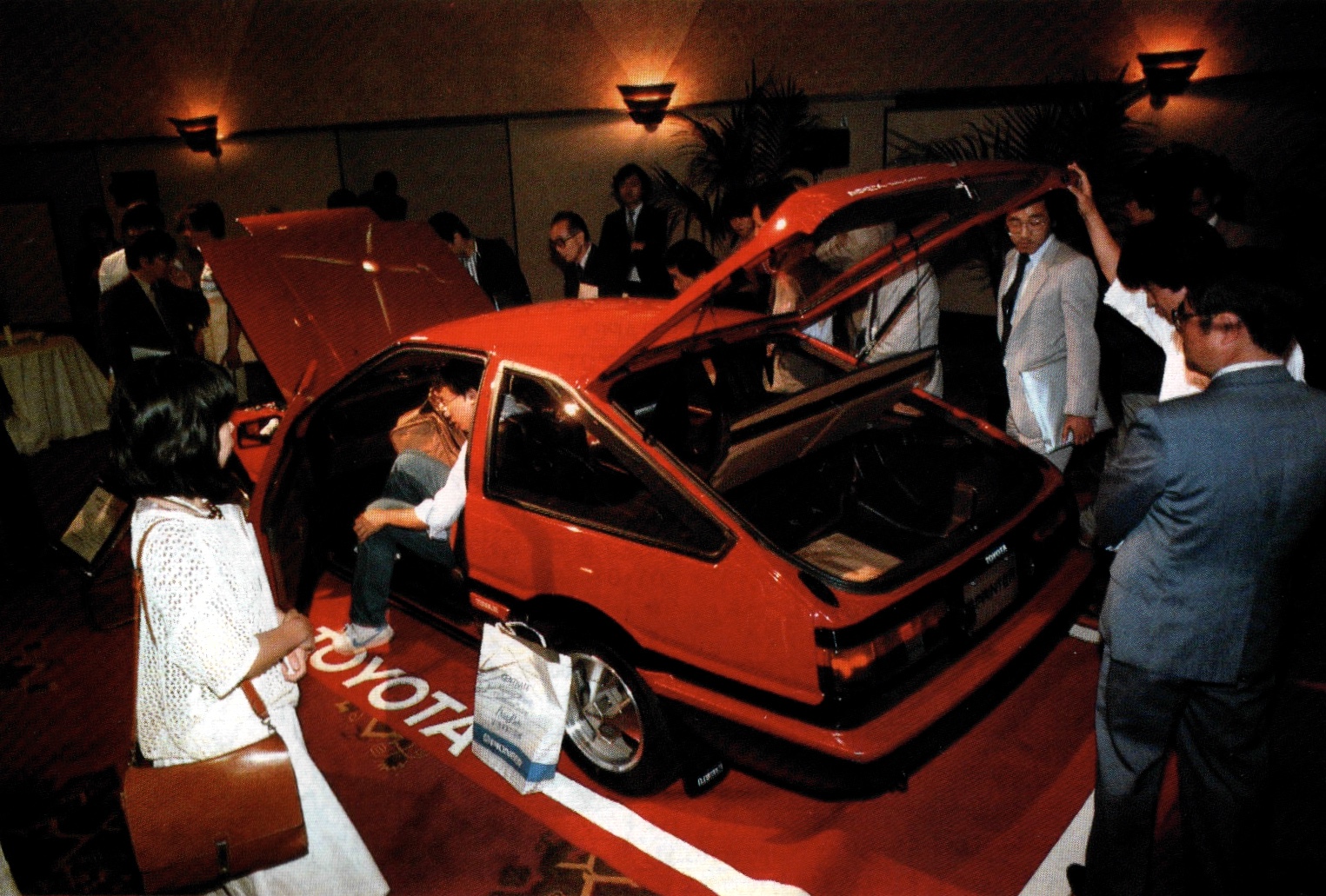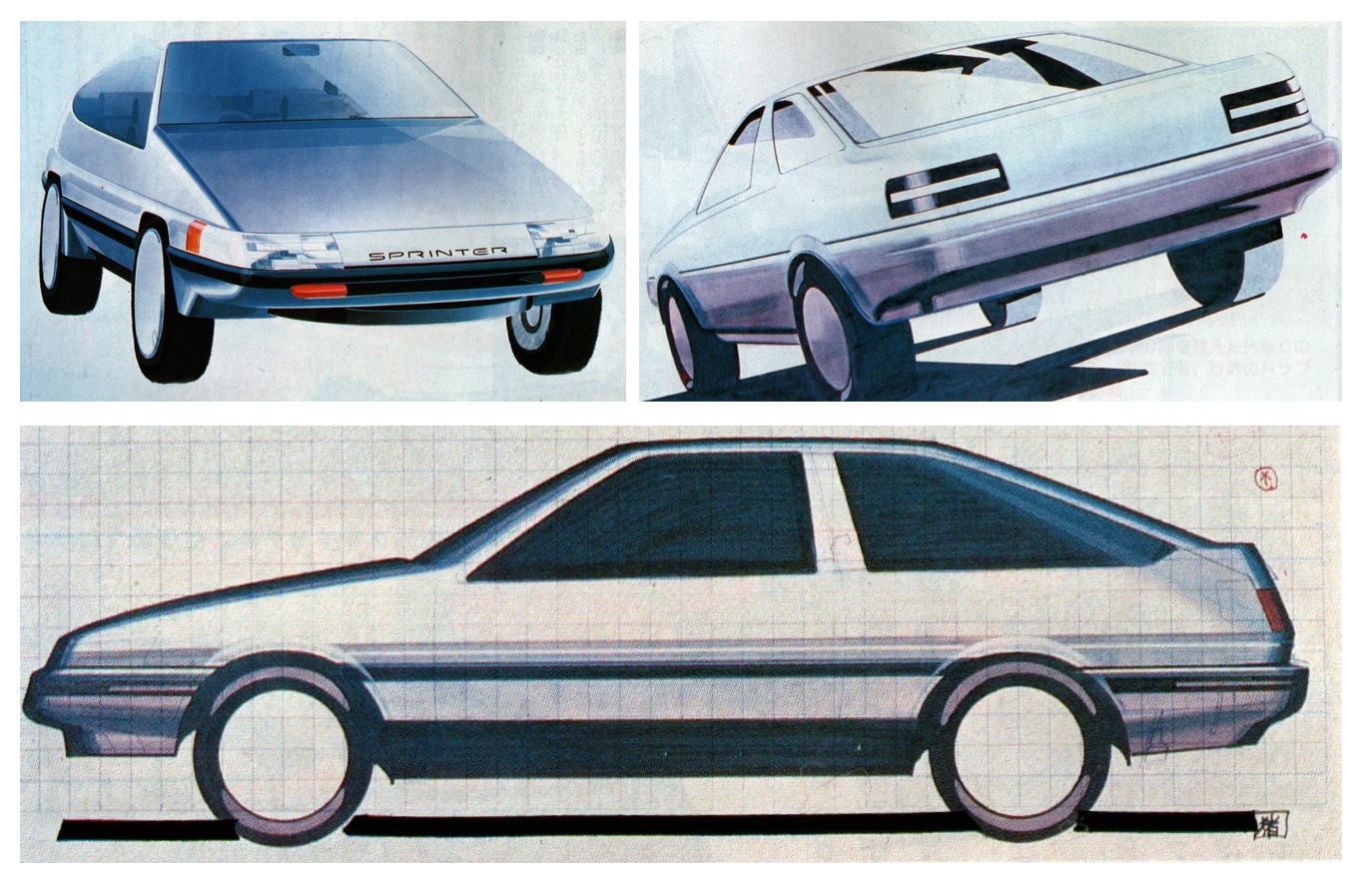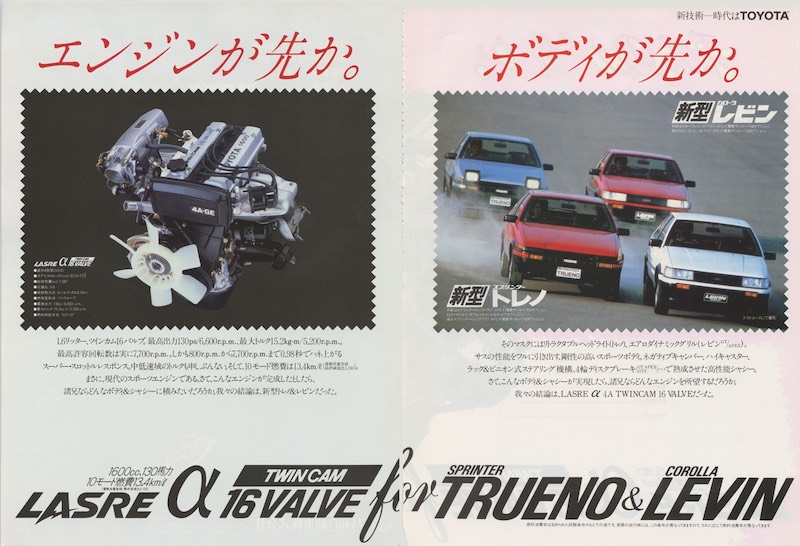Two days ago the Corolla Levin and Sprinter Trueno AE86 celebrated their 40th birthday! On May 12th 1983 the fifth generation (E80) of the Corolla and Sprinter were presented to the press.

This presentation was a major event as Toyota decided to move its main platform to front-wheel drive. At the same time, Toyota decided the sporty Levin and Trueno models should retain rear-wheel drive and carry over the floorpan of the fourth generation. To make things more complex, Toyota decided to merge the two-door hardtop into the Levin and Trueno range and this became a two-door non-hardtop sold as a hardtop. This made the new generation of Levin and Trueno more diverse and featured four distinct body styles. This lineup included four door sedans, five door liftbacks and, most importantly, the 2 door and 3 door Levin and Trueno AE86!
No front wheel drive for the AE86
The design of the fifth-generation Corolla and Sprinter began under the supervision of Chief Engineer Fumio Agetsuma in March of 1979. His team included Takayasu Honda and Nobuaki Katayama, where the former would become Chief Engineer for the eighth generation Corolla and Sprinter and the latter would become Chief Engineer for the fourth generation Supra and first generation Altezza/Lexus IS. Their goal was to get the fifth generation on a front-wheel-drive platform that basically just got launched months prior with the all-new Tercel. Their first trial was to mate the front of the Tercel to a fourth-generation E70, creating the 4WD Sprinter Carib that we better know as the 4WD Tercel overseas. This development car proved that their strategy worked and they continued to work on the front-wheel drive Corolla. Finally, in November 1979 the official decision was made to change the next-generation Corolla and Sprinter to front-wheel drive.
Strangely enough, they decided not to move the sporty Levin and Trueno to the new front-wheel-drive platform but kept it on the front engine rear wheel drive (FR) platform of the fourth generation. The AE86 planning manager, Mikio Kaneko, explains this as FR was still considered to be superior on the track and in rally. We don’t know exactly what Nobuaki Katayamas role was within the team, but some sources claim that his main focus on the AE86 was to improve the handling of the E70-derived chassis.
Design of the AE86

The designer, Michio Inoko, made an initial design for the fifth generation sports coupé based upon the three-door Sprinter Trueno. He then used this as a base for designing the three-door Levin variant and, later, both two-door variants. He carried over one important design element from the front-wheel-drive sedans: the lowered beltline was the design motif of the fifth generation Corolla and Sprinter, so the two-door and three-door sports coupé had to feature it as well.

Another design element Inoko copied from the Soarer Z10 was the B-pilar. He took inspiration from the Porsche 928 which has a B-pilar that leans forward. He recreated this design motif on the Soarer Z10. When he designed the two-door shape he copied this design motif as well. The three-door also received the forward leaning B-pilar as it had to share the same door with the two-door model.
Production of the AE86
Production of the AE85 and AE86 started in early May 1983 in the Tahara and Higashi Fuji plants in Japan. The Tahara plant is located in Tahara, Aichi and is still in use today. The Higashi Fuji plant was located in Susono, Shizuoka and has been closed down in 2020. Tahara was the main production plant, however when production started both factories produced roughly the same number of cars.
However in July 1984 production was decreased drastically in Higashi. According to some sources the Higashi Fuji plant was only used to offload demand. These two factories are 200 kilometres apart, so the supply chain of parts must have been quite costly, hence scaling down production in the secondary plant. This also explains why the production in Higashi fluctuates a lot during the first year of production. In February 1987 production first stopped in the Higashi plant and in July later that year the Tahara plant followed suit. In total Tahara produced 323,876 cars while Higashi produced 119,405 cars. This means Higashi accounted for 27% of the total production. Of this total production, about 10% was sold overseas. With so many cars produced, it underlines that the AE86 was a big hit!
Selling the AE86 to the public
Planning Manager Mikio Kaneko set three goals for the new Levin and Trueno AE86 to make it sell well: 1) set the fastest lap at Tsukuba Circuit for naturally aspirated cars with a sub-1600cc displacement, 2) win the (domestic) rally championship in the sub-1600cc class and 3) exceed a top speed of 200km/h.

The fastest lap at Tsukuba Circuit was achieved at one minute and 18 seconds. This record stood for the next two years until it finally was beaten by the new Honda Civic.
The domestic Rally Championship was easily achieved as both amateur and professional rally drivers quickly showed up en masse with the all-new two-door Levin or two-door Trueno. It even showed up at the All Japan rally which was held only 10 days after the AE86 release. Also outside Japan, the two-door AE86 proved to be a popular and winning car.
Exceeding a top speed of 200km/h was dropped as the engineers questioned whether the live-rear axle would be able to sustain such speeds and also the Japanese maximum speed on the speedometer was limited to 180km/h. Boasting about a new car being able to surpass the 180km/h limit greatly was deemed inappropriate. The goal was lowered to 190km/h and this speed was achieved and advertised overseas in Europe. In Germany the top speeds advertised is 190km/h for the AE86 with catalytic converter and 195km/h for the AE86 without.
The AE86 in present day
Today the AE86 is still popular for what it is: a fun to drive FR sports car. No frills, no advanced electronics, no huge power output. Just a light sporty car, a limited slip differential and loads of fun! 40 years ago it was presented to the world and today we celebrate its 40th birthday!
Some parts of this posting are excerpts from the book I’m writing about the AE86. There are so many more details about the AE86 that I had to filter down this posting to the most essential text. Hopefully more news on the book soon!
Thank you for this, Art. I wish you all the
success for your book.
The Higashi plant closed down and is currently
in the process of becoming a development site
for connected cities and autonomous driving.
The project is called Toyota Woven City and
Toyota has started a new subsidiary called
Woven by Toyota (formerly Toyota Research
Institute – Advanced Development) to develop
mobility concepts.
Cool to see, that my car’s place of origin (the
Higashi plant) enables development for future
mobility solutions.
Cheers,
Mehmet